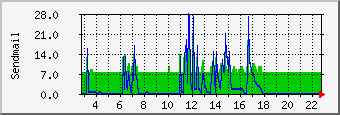I just stumbled across something I thought was interesting. All the .mil domain names used by the U.S. Military are served by one single root server. I thought that was a bit odd. I'm sure that one server is more than enough to handle the queries for all the .mil domains with no problem, but it doesn't seem very redundant or safe at all. Especially for something our military uses. There's something that could be beefed up a little bit. My other thought (which others may know) was that perhaps the military runs G.ROOT-SERVERS.NET and I'm just not aware of it. Maybe it's a policy to only run .mil on what they can control? Even still, I think it might be in their best interest to setup a few more.
These are the results I got when I queried A.ROOT-SERVERS.NET:
; <<>> DiG 9.2.1 <<>> @a.root-servers.net mil.
;; global options: printcmd
;; Got answer:
;; ->>HEADER<<- opcode: QUERY, status: NOERROR, id: 41
;; flags: qr aa rd; QUERY: 1, ANSWER: 0, AUTHORITY: 1, ADDITIONAL: 0
;; QUESTION SECTION:
;mil. IN A
;; AUTHORITY SECTION:
mil. 86400 IN SOA G.ROOT-SERVERS.NET. HOSTMASTER.N
IC.mil. 2002082000 3600 900 1209600 86400
;; Query time: 390 msec
;; SERVER: 198.41.0.4#53(a.root-servers.net)
;; WHEN: Wed Aug 21 15:38:58 2002
;; MSG SIZE rcvd: 90
I'd like comments from anyone with more information on this. I'm just curious as to why it is this way and what the reasoning behind it is. Maybe I'll email hostmaster.nic.mil and ask. 
Vinny Abello
Network Engineer
Server Management
vinny@tellurian.com
(973)300-9211 x 125
(973)940-6125 (Direct)
PGP Key Fingerprint: 3BC5 9A48 FC78 03D3 82E0 E935 5325 FBCB 0100 977A
Tellurian Networks - The Ultimate Internet Connection
http://www.tellurian.com (888)TELLURIAN
